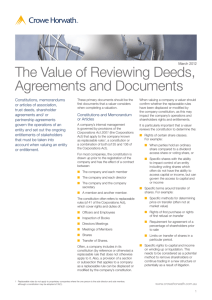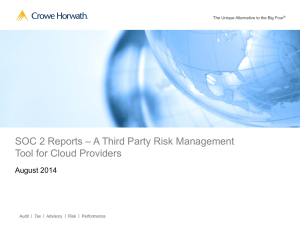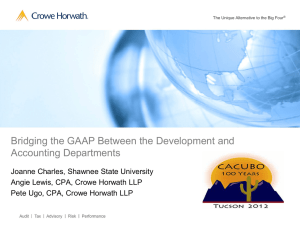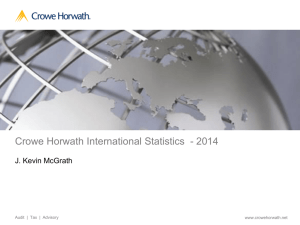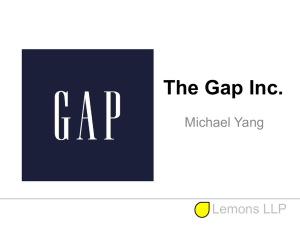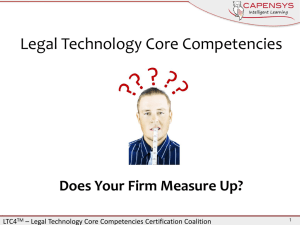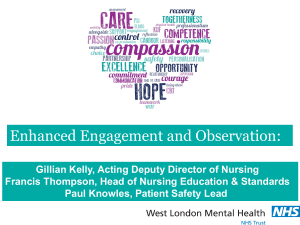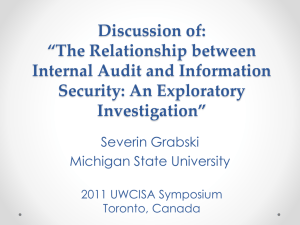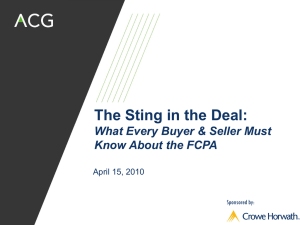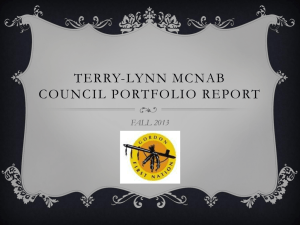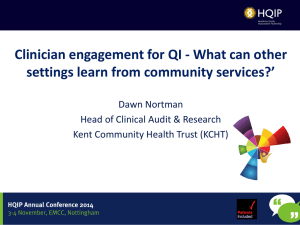Personal Finance--things to think about
advertisement
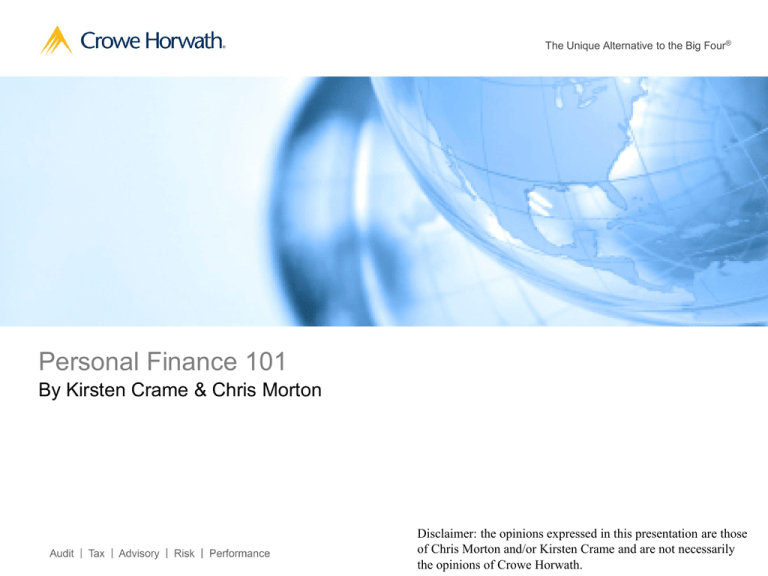
The Unique Alternative to the Big Four® Personal Finance 101 By Kirsten Crame & Chris Morton Disclaimer: the opinions expressed in this presentation are those of Chris Morton and/or Kirsten Crame and are not necessarily the opinions of Crowe Horwath. The Unique Alternative to the Big Four® EVERYTHING YOU NEED TO KNOW ABOUT FINANCE Spend less money than you make. -The end Audit | Tax | Advisory | Risk | Performance © 2013 Crowe Horwath LLP 2 The Unique Alternative to the Big Four® Agenda Savings & Debt Personal Government Investing Credit Cards & Credit Scores Insurance HSA vs FSA’s Your new job and where to move Buying a House Q&A Audit | Tax | Advisory | Risk | Performance © 2013 Crowe Horwath LLP 3 The Unique Alternative to the Big Four® Personal Savings & Debt Audit | Tax | Advisory | Risk | Performance © 2013 Crowe Horwath LLP 4 The Unique Alternative to the Big Four® Some not so fun facts about America’s saving problem… We’re right back where we started before the crisis…. at a 2% savings rate! Other OECD Countries 2013 Personal Savings Rates • • • • Switzerland 13.9% Germany 10.3% Australia 10.2% Sweden 12.4% http://www.oecd-ilibrary.org/economics/household-savingrates-forecasts_2074384x-table7 Audit | Tax | Advisory | Risk | Performance http://www.economist.com/blogs/freeexchange/2013/04/saving © 2013 Crowe Horwath LLP 5 The Unique Alternative to the Big Four® US Government Savings & Debt Since 2008, the government debt has nearly doubled. Deficit= Annual Spending – Annual Revenue Debt = Cumulative Deficits Harmful effects of high government debt: Reduced private investment in productive capital Federal spending on interest payments rises Higher taxes are needed to cover interest obligations Risk of fiscal crises http://research.stlouisfed.org/fred2/data/GS10.txt Audit | Tax | Advisory | Risk | Performance 6 www.brillig.com/debt_clock/ © 2013 Crowe Horwath LLP The Unique Alternative to the Big Four® US Government – A Going Concern Problem Why don’t we feel the pain of the US debt doubling over the last ~5/years? • • • Historically low interest rates The gov’t is currently rolling over their debt in short term >5/yr maturities (although the trend is to lengthen maturities in the future) No current fire sale • Here’s a hypothetical; if interest rates on the 2 year went up to what they were in 2000, interest expense would be $1 TRILLION, up from $416 billion! (using the current $16.7T outstanding debt) – Larger than the Social Security Administration • Currently, the FED gov’t takes in $2.7T in gross receipts, that would mean 37% of our taxes/fines/etc would go to servicing the debt alone! (currently 15%) Audit | Tax | Advisory | Risk | Performance http://www.usgovernmentrevenue.com/fed_revenue_2013USrn http://www.treasurydirect.gov/govt/reports/ir/ir_expense.htm © 2013 Crowe Horwath LLP 7 The Unique Alternative to the Big Four® Saving (“The aim of the wise is not to secure pleasure, but to avoid pain.” – Aristotle) The first step to living debt free is to create a budget • Know what to prioritize • • Eg. Room/board, then food, then transportation, etc Separate out your needs (rent/food/beer) versus wants (new phone/restaurants/movies) • There are plenty of resources to create your own budgets including… • • Excel default spreadsheets https://www.mint.com/how-it-works/accounts/ (1:30/min video) • Learning to save is critical in today’s world of immediate gratification and a global flexible work force • Above all else, do SOMETHING! Audit | Tax | Advisory | Risk | Performance © 2013 Crowe Horwath LLP 8 The Unique Alternative to the Big Four® Once you’ve got the savings down, now the fun part… Investing! • Rule of 72 (doubling time) • Ex, if you were to invest $1,000 with compounding interest at a rate of 9% per annum, the rule of 72 gives 72/9 = 8 years required for the investment to be worth $2,000. “Compound interest is the eighth wonder of the world. He who understands it, earns it ... he who doesn't ... pays it.” ― Albert Einstein • How to invest? • • • 401k: $17.5k for 2013 annual limit IRA & Roth IRA: Lesser of earned income or • • • $5.5k for 2013 annual limit Be careful of expense ratios… Start your own business! Audit | Tax | Advisory | Risk | Performance © 2013 Crowe Horwath LLP 9 The Unique Alternative to the Big Four® Traditional IRA vs. Roth IRA Traditional IRA- money contributed is pre-tax and will be taxed when it is distributed “tax deferred” earnings & current year deduction on page 1 of your 1040 Qualified distributions begin at age 59½. Required minimum distributions begin at age 70½. No AGI limits on who can contribute Beneficiaries pay taxes on inherited IRAs. After 5 years, up to $10k can be withdrawn penalty free to cover first time homebuyer expenses, but tax will be due on the distributions. Roth IRA- money contributed is post tax and will not be taxed when distributed “tax exempt” earnings because the principal was taxed, and now will grow tax free Single people- Modified AGI< $125k Married people- Modified AGI< $183k (this is an example of a marriage penalty) Qualified distributions begin at age 59½. No required minimum distributions wealth can be transferred without beneficiaries owing income tax After 5 years, up to $10k can be withdrawn penalty free to cover first time homebuyer expenses, no tax on distribution http://www.rothira.com/traditional-ira-vs-roth-ira Audit | Tax | Advisory | Risk | Performance © 2013 Crowe Horwath LLP 10 The Unique Alternative to the Big Four® Traditional IRA vs. Roth IRA- so which one should I have? You can have both! People who believe their current tax rate is lower now than it will be when they retire typically invest in Roth IRAs so that they are taxed currently at their low rate, and then they plan to take distributions tax free when taxes are higher. People who are currently in a high tax bracket contribute to their traditional IRA to reduce their taxable income in the current year. The higher your tax rate is currently, the more benefit you get by contributing to a traditional IRA. People can “hedge” themselves by investing in both- just not more than $5.5k total for 2013 amongst IRA & Roth IRA accounts 2013 Income Tax Rates Audit | Tax | Advisory | Risk | Performance http://www.taxpolicycenter.org/taxfacts/content /pdf/individual_rates.pdf © 2013 Crowe Horwath LLP 11 The Unique Alternative to the Big Four® What if you need to take money from your retirement account? Avoid taking money from your retirement if possible 401k withdrawals before age 59 ½ are subject to tax and a 10% penalty Early Roth IRA distributions of income are subject to tax (they wouldn’t be if it was a regular distribution instead of an early distribution) and a 10% penalty. There are some exceptions that will get you out of tax & penalty such as certain medical expenses, home purchases, disability & a few other things. Major point: You can withdraw the Principal you contributed to a Roth IRA at any time with no tax or penalty! If you change jobs, you can rollover many types of retirement accounts from one company to another (usually must happen in a 60 day window) The tax document you will receive if you do this is a 1099-R Double check the coding in box 7 to make sure its coded correctly Report any early distributions (regardless of if they are taxable or not) on form 5329 of your tax return. http://taxes.about.com/od/retirementtaxes/a/early_penalty.htm Audit | Tax | Advisory | Risk | Performance © 2013 Crowe Horwath LLP 12 The Unique Alternative to the Big Four® What should I invest in? • This is ultimately your decision and based on risk tolerance, however someone under 40 typically should be in high risk assets • Small cap stocks (Russell 2000) (2012 returns of 17.28%) – Source Russell.com • Using the rule of 72, your investment will double in 72/17.28 ~=4.2/years! • Mutual Funds • An investment program funded by shareholders that trades in diversified holdings and is professionally managed • Exchange Traded Fund (ETF) • • • ETFs seek to track an underlying index’s performance over time A mutual fund that is traded on a stock exchange Emerging market or foreign stocks through an ETF • What’s an index? • An imaginary portfolio of securities representing a particular market or a portion of it • It’s a group of stocks, bonds, or both! • Ex. Vanguard Total World Stock Idx Fd (Symbol VT) • 2012 performance of 15.55% - Source Google Finance Audit | Tax | Advisory | Risk | Performance © 2013 Crowe Horwath LLP 13 The Unique Alternative to the Big Four® Audit | Tax | Advisory | Risk | Performance © 2013 Crowe Horwath LLP 14 The Unique Alternative to the Big Four® ETF expense ratio comparison Similar ETFs Audit | Tax | Advisory | Risk | Performance © 2013 Crowe Horwath LLP 15 The Unique Alternative to the Big Four® Personal Risk Tolerance There are several risk tolerance calculators on the internet These help you decide how to invest For example, a young professional with no children and a full time job probably has a higher risk tolerance than an older person who is not working and is dependent on social security. Investments for people with low risk tolerance tend to be value stocks/mutual funds/ETFs and short/medium term bonds. Investments for people with high risk tolerance tend to be growth oriented stocks/mutual funds/ETFs Audit | Tax | Advisory | Risk | Performance © 2013 Crowe Horwath LLP 16 The Unique Alternative to the Big Four® Diversification Stocks Bonds Commodities Crops Steel Precious metals Timber REITS Cash Personal Home Rental Properties Collectables Audit | Tax | Advisory | Risk | Performance © 2013 Crowe Horwath LLP 17 The Unique Alternative to the Big Four® Credit Cards • These can be a blessing or a curse depending on how you use them, here are some things you should know: • • • • • • • Is there an introductory rate? When, and by how much, will it increase? Is there an annual fee? How much is it? What is the grace period? Is online banking available? What is the credit limit? No interest if you pay the full bill every month What other fees are attached to the card and how are they assessed? (ex: transaction fees foreign exchange fees)? • Are there any offers or rebates associated with the card (ex: frequent flyer miles)? • What type of offers/rebates are relevant to you? (e.g. do you travel, like to shop, need 0% intro APR) Audit | Tax | Advisory | Risk | Performance © 2013 Crowe Horwath LLP 18 The Unique Alternative to the Big Four® Credit Cards www.creditcards.com allows people to compare credit cards Audit | Tax | Advisory | Risk | Performance © 2013 Crowe Horwath LLP 19 The Unique Alternative to the Big Four® Typical Current Interest Rates Student Loans- about 6% Credit Card Debt- about 19% - 25% Cash Advances (such as AMSCOT) 10% - 250% Checking Accounts 0% Short Term CDs .25% Long Term CDs 1.1% Audit | Tax | Advisory | Risk | Performance Car Loans- about 2% - 9% House Loans- about 3% - 7% Savings Accounts .1%-.25% Money Market .2% https://partnersfcu.org/everyday-banking/rates/#certificates © 2013 Crowe Horwath LLP 20 The Unique Alternative to the Big Four® How to Get out of Debt Pay off your highest interest rate debt first For most people, this is usually credit card debt. It is normal for credit card debt to accrue interest at 20% APR or more. The average household has $15,950 of credit card debt. Some student debt loans are higher than others, you may be able to chose which ones you pay first Don’t put double payments towards your mortgage if you’ve got other debt at a higher rate Write down everything you buy so you see where your money goes, then eliminate nonessentials. Pay credit cards in full monthly- do not carry a balance Be a member at a credit union instead of a bank- usually lower fees/no fees http://money.cnn.com/magazines/moneymag/money101/lesson9/index.htm Audit | Tax | Advisory | Risk | Performance © 2013 Crowe Horwath LLP 21 The Unique Alternative to the Big Four® How to Get out of Debt…continued Do a balance transfer to a 0% balance transfer credit card to buy yourself time to pay off credit card debt with little or no interest (there usually is a 4% fee for this.) Absolutely do not take PayDay loans or cash advances. These typically have interest rates of 10%-250%! Be weary of things like Angie’s List: Automatic credit card charges & renewals Almost impossible to get out of Bad reviews all over the internet Allegations of “rigged” ranking of vendors You can get the info you’re looking for from the Better Business Bureau for free Learn how to cook & buy groceries. It’s cheaper and healthier than restaurants Consolidate/Negotiate debt down Alternative methods Pay off lowest “total debt” first to feel accomplished that you have less debts. This is less rational than the methods above, but it may give you an emotional boost. Audit | Tax | Advisory | Risk | Performance © 2013 Crowe Horwath LLP 22 The Unique Alternative to the Big Four® Your Credit Score DO NOT SIGN UP FOR “FREE CREDIT REPORT SERVICES” or any kind of credit monitoring • Can pull your credit once a year from each of the 3 bureaus • I pull mine once every 4 months • FICO score doesn’t matter as long as you pay your credit card off each month and use less than 50% of your credit card limits • Check out www.creditkarma.com for free account monitoring and FICO score • Worried about identity theft? Freeze your credit! Audit | Tax | Advisory | Risk | Performance © 2013 Crowe Horwath LLP 23 The Unique Alternative to the Big Four® Building Credit Start building credit by getting a credit card- preferably one with no annual fees and some sort of rewards. Open credit accounts with stores you love- Macy’s, Rooms to Go etc. Have things in your name such as apartments, utilities and phone contracts Don’t carry high balances on lines of credit. Buy a car (if you need one) Get a job and keep it Don’t get evicted Pay your bills in full and on time. Open a savings account if you don’t already have one Avoid bankruptcy- “the credit equivalent of poison” Mars your credit report for 10 years Don’t get arrested Criminal convictions stay on your credit report forever Audit | Tax | Advisory | Risk | Performance © 2013 Crowe Horwath LLP 24 The Unique Alternative to the Big Four® Audit | Tax | Advisory | Risk | Performance © 2013 Crowe Horwath LLP 25 The Unique Alternative to the Big Four® Sneaky Bank Tricks Subtracting Electronic payments early Payments were deducted from customer accounts but not paid to the creditor on same day Wachovia (now Wells Fargo) and other banks got in trouble when customers learned funds were taken out 2-5 days before payment was due, thus giving the banks several days of float Ordering transactions from high to low Banks used to post transactions chronologically, but now are choosing to process transactions by size paying the highest ones first when they realized this increased customers chances of over drafting Debit Card Overdraft Fees The purpose of debit cards was to prevent the customer from spending more than hey had Banks found that approving over draft fees for the “convenience” of their customers was very lucrative In fact, many banks now make it difficult to opt out or even say they cannot prevent payments from clearing even though there is no money in the account “Privacy Assist” security monitoring services offered by banks Unneeded and difficult to get out of- monthly automatic fees deducted from accounts Prey on the poorest people by then charging overdraft fees Audit | Tax | Advisory | Risk | Performance http://www.businessweek.com/articles/2013-06-11/debit-card-overdraft-fees-remain-profitable-for-banks http://www.huffingtonpost.com/2010/02/25/bank-of© 2013 Crowe Horwath LLP 26 america-sued-for_n_475694.html The Unique Alternative to the Big Four® Insurance • Remember that the goal of insurance is solely to mitigate risk • Only buy the coverage you absolutely need • When you need life insurance • • If no one is depending on your income (children/spouse) then you probably don’t need life insurance. Most accounting firms give life insurance to workers as one of their benefits. • Whole vs term • Whole • • • • • Can access up to 2/3 of value while still alive if there is a terminal illness More expensive Cash surrender value Guaranteed rate of return Term • • • Cheaper For specified time Only pays out if someone passes • How much do you need and why? Audit | Tax | Advisory | Risk | Performance © 2013 Crowe Horwath LLP 27 The Unique Alternative to the Big Four® HSA & FSA • Health Savings Accounts (HSA) and Flex Spending Accounts (FSA) are becoming more common health insurance plans. • HSA details: • Contribution limits- Individuals $3,250 & Families $6,450 • Requires a HDHP (high deductible health plan) and minimum required deductibles • • • • Deductibles- Individuals $1,250 & Families $2,500 Lower premiums and much higher deductibles than a traditional health plan. Also called catastrophic illness plans, great for young people due to low premiums Contributions to HSAs can be carried over year to year, and they can be invested. • FSA Details • $2,500 employee cap • Allows you to contribute money to the FSA for costs not covered by insurance: deductibles, co-pays, and coinsurance. In addition, you can use your FSA to pay for health care costs that health insurance doesn’t cover. Audit | Tax | Advisory | Risk | Performance © 2013 Crowe Horwath LLP 28 The Unique Alternative to the Big Four® HSA & FSA continued… • Compare/Contrast • Unlike HSA’s, funds in FSA’s that are unused over $500 when the plan year is over are lost and cannot be carried over to the following year. (updated 11/1/13) • Neither allow expenses for over the counter drugs except insulin or if prescribed • Unlike health savings accounts or health reimbursement accounts, FSAs are more commonly offered with traditional medical plans • Contributions to HSAs can be made for the 2013 tax year up until April 15, 2014. • Contributions to traditional and Roth IRAs for the 2013 tax year also can be made up until April 15, 2014. Audit | Tax | Advisory | Risk | Performance © 2013 Crowe Horwath LLP 29 The Unique Alternative to the Big Four® New job and where to move • Check out the Robert Half salary guide (2014 now available) • Know what the cost of living will be when looking at salaries • Other things to look for: (Google/Wikipedia) • • • • • • Total unemployment/job growth Cost of living/median home price Average Salary School system Age Things to do Audit | Tax | Advisory | Risk | Performance © 2013 Crowe Horwath LLP 30 The Unique Alternative to the Big Four® Buying a house • How much down payment? • How much house can you afford? • Items to be wary of when buying • • • Ask your lender/Realtor how they make money Closing costs (Typically 3% of home cost) Buying furniture after the purchase, security deposits, etc. • Consider 10 or 15 year loan instead of 30 year loan • 15 year loans typically are .25% lower interest than 30 year Audit | Tax | Advisory | Risk | Performance http://www.realtor.com/home-finance/buyers-basics/what© 2013 Crowe Horwath LLP are-my-mortgage-options.aspx?source=web 31 The Unique Alternative to the Big Four® Mortgage Options Conventional mortgages Meet the funding criteria of Fannie Mae or Freddie Mac About 35-50% of the market (depending on location) May be fixed-rate or adjustable-rate (certain circumstances interest-only) Fixed = interest rate doesn’t change Adjustable = interest rate adjusts to prevailing rate (usually based on an index plus a certain margin – ex- libor +1) Interest only – Pay only interest, balloon payment due after certain duration http://www.usa.gov/topics/family/homeowners/buyingselling/mortgages/types.shtml Audit | Tax | Advisory | Risk | Performance © 2013 Crowe Horwath LLP 32 The Unique Alternative to the Big Four® Mortgage Options FHA mortgages Benefits include 100% financing (minimum of 3% down, can be gifted and applied to closing costs) Sellers must pay part of the closing costs Disadvantage is that the PMI (private mortgage insurance) does not go away after meeting a certain equity threshold (usually 20% for conventional) In most cases, borrower pays 1.5% of loan amount at closing along with a .5% annual renewal premium paid over life of loan May qualify for partial refund after 5/yrs under certain circumstances http://www.bankrate.com/finance/mortgages/4-mortgages-that-require-little-money-down-2.aspx Audit | Tax | Advisory | Risk | Performance © 2013 Crowe Horwath LLP 33 The Unique Alternative to the Big Four® Mortgage Options First time home buyer loan programs Offers vary by state and lender Little or no down payment & reduced closing costs and fees Allow lower credit scores & higher debt ratios Typically total loan would be less than conventional loan Must be primary residence & may be difficult to refinance Department of Agriculture (USDA) Rural Development loans No mortgage insurance, but 2% guarantee fee Intended for first time home buyers Not confined to farmland Income restrictions Veterans Administration (VA loan) Qualified veterans can get zero down payment mortgages with no mortgage insurance and reduced rates (2.15%-3.3%) http://www.bankrate.com/finance/mortgages/4-mortgages-that-require-little-money-down-2.aspx Audit | Tax | Advisory | Risk | Performance http://portal.hud.gov/hudportal/HUD?src=/program © 2013 Crowe Horwath LLP _offices/housing/sfh/pred/predlend 34 The Unique Alternative to the Big Four® For more information, contact: Kirsten Crame Direct 813-209-2464 Kirsten.Crame@crowehorwath.com Chris Morton Direct 813-209-2466 Chris.Morton@crowehorwath.com Crowe Horwath LLP is an independent member of Crowe Horwath International, a Swiss verein. Each member firm of Crowe Horwath International is a separate and independent legal entity. Crowe Horwath LLP and its affiliates are not responsible or liable for any acts or omissions of Crowe Horwath International or any other member of Crowe Horwath International and specifically disclaim any and all responsibility or liability for acts or omissions of Crowe Horwath International or any other Crowe Horwath International member. Accountancy services in Kansas and North Carolina are rendered by Crowe Chizek LLP, which is not a member of Crowe Horwath International. © 2013 Crowe Horwath LLP Audit | Tax | Advisory | Risk | Performance © 2013 Crowe Horwath LLP 35 The Unique Alternative to the Big Four® Mint.com https://www.mint.com/how-it-works/accounts/ Choose to save.org http://www.choosetosave.org/calculators/ Debt Clock http://www.usdebtclock.org/ Vanguard https://personal.vanguard.com Free credit monitoring & FICO score www.creditkarma.com Freeze your credit http://www.clarkhoward.com/news/clark-howard/consumerissues-id-theft/credit-freezes-are-effective-tool-against-data-bre/nMgx3/ Credit Cards.com www.creditcards.com Crowe Horwath LLP is an independent member of Crowe Horwath International, a Swiss verein. Each member firm of Crowe Horwath International is a separate and independent legal entity. Crowe Horwath LLP and its affiliates are not responsible or liable for any acts or omissions of Crowe Horwath International or any other member of Crowe Horwath International and specifically disclaim any and all responsibility or liability for acts or omissions of Crowe Horwath International or any other Crowe Horwath International member. Accountancy services in Kansas and North Carolina are rendered by Crowe Chizek LLP, which is not a member of Crowe Horwath International. © 2013 Crowe Horwath LLP Audit | Tax | Advisory | Risk | Performance © 2013 Crowe Horwath LLP 36
